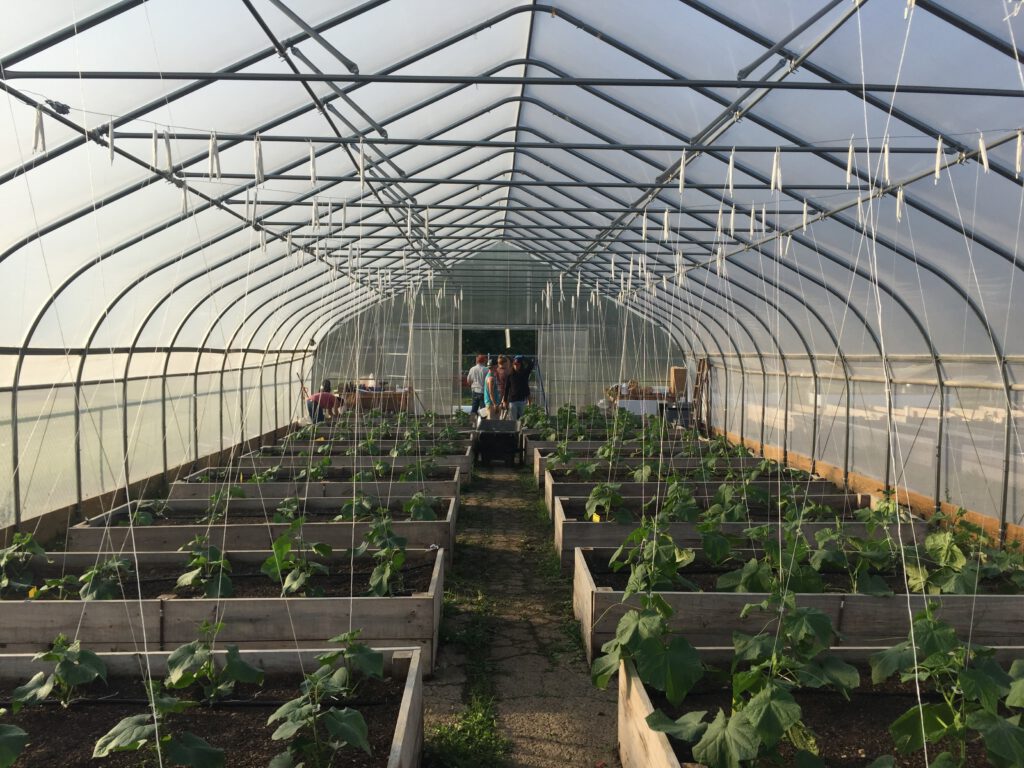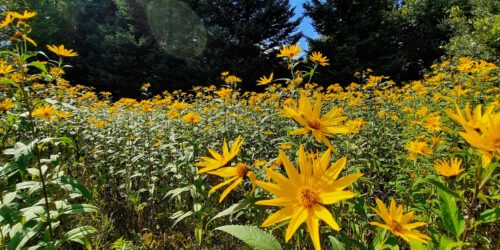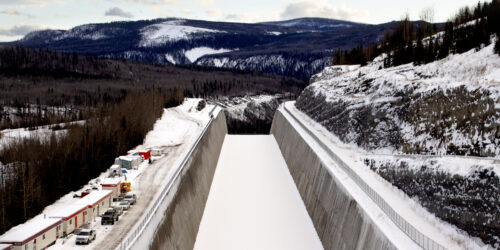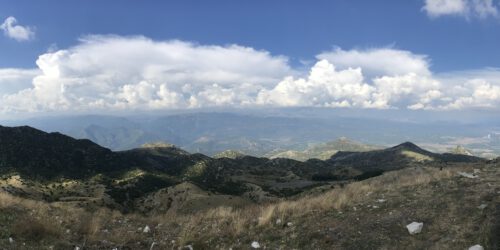Histories of the Future: Urban Microfarming as an Elegant Solution for a Just and Sustainable World

This post by Kent Curtis originally appeared as part of a series on Environmental Histories of the Future on NiCHE, the Network in Canadian History & Environment.
I’m an environmental historian, a humanist, and I am currently leading an interdisciplinary 3-year, $2 million urban agriculture research project. I submit that this is no accident and, instead, represents a future path for environmental historians interested in moving beyond the monograph and out into the world of convergence research and sustainable futures. I want to suggest a methodology to construct what we might call “histories of the future.”
Let me begin with the project on the ground. With the three-year grant, we’re building, supporting, cultivating, launching, and studying a solution-oriented approach to urban food production: the microfarm system. It starts with a right-sized urban production site, the microfarm, designed to be small enough for an individual or household to operate, but large enough to bring an income. Microfarmers are trained to grow a select group of high-demand specialty crops—tomatoes, cucumbers, carrots, beans, greens, about a dozen in all—and their production is coordinated by a marketer employed by the farmer cooperative, called Richland Gro-Op, that the microfarmers own together. The cooperative’s marketer coordinates crop plans with microfarmers to meet known market demand and in this way facilitate a greater degree of certainty for farmers and buyers alike. Microfarms in low-opportunity communities and households have the potential to address food insecurity at its source, household income. They do this by capturing existing food dollars to deliver wealth where wealth is needed. This story, which is now being implemented by real people on the ground in Mansfield, Ohio began as a history of the future, a story about the possibility of this solution and its many potential benefits.

That is to say that this project emerged as a new set of stories about urban agriculture itself. After more than a decade that saw urban gardens and farms promoted as the solution to food deserts and household food insecurity, it was clear that urban agriculture had offered a mixed blessing at best and risked creating a kind of green colonialism at worst. Urban farmers were being asked to aggregate all of the work of food production and food literacy—marketing, education, health, community service—into one site and to serve all of the pressing needs around food issues in their communities at the same time. The urban agriculture movement often delivered a whole new set of responsibilities and expectations to low-opportunity neighbourhoods and foisted onto the shoulders of low-income individuals and households the burden of farming and fund raising and education and marketing. University researchers then studied these efforts for their various failures and harvested a crop of published research without witnessing the successful delivery of food or wealth into these spaces.[1]
Approaching the question of social justice with the answer “access to opportunity,” the microfarm project acknowledged the insufficiency of free food as a robust solution to the problem of household food insecurity. As it targeted the question of social justice, the microfarm system has identified racial inequity and racial injustice as a historic, pressing, and core set of entrenched social wrongs that deserved a laser focus. The revision that we offer to the story of urban agriculture began with geographies, demographics, and data in order to zero in on the specific places where people most in crisis have aggregated. But then it shifted to those people and the households and neighbourhoods where social capital and development assets were lying in wait. Our microfarming story aimed to seize the opportunity that existed to mitigate the crises faced by individuals and households in these spaces with a sustainable solution.
In this way, we’re setting out to solve what some social scientists call a “wicked problem” with an elegant solution, and would like to encourage all environmental humanists, and especially those working in U.S. land grant universities, to try this at home. Environmental humanists have the tools to construct viable histories of the future designed to address lived injustice in place and time and through them to catalyze restorative social circumstances and more sustainable practices and processes. And they are well-positioned to address the tangle of belief and moral valuation – and the story-telling architecture that forms them—lying at the base of our social and ecological crises. As masters of narrative and narrative technique with a commitment to narrative fidelity, they promise to bring the gaze of intelligent tinkerers and the ambitions of creative, collaborative problem-solvers.

Environmental scientists and social scientists often describe the challenge of the human political subject in ecological thought (both individually and collectively) as presenting a “wicked problem.” The “problem” is often framed in terms of a mismatch between some known earth system crisis (climate change, loss of biodiversity, etc.) and the ability of human intelligence to understand and react to this crisis. The term “wicked problem” acknowledges in one fell swoop the ever-present reality of active human free will, the murkiness of concepts like human culture and value, and the presence of the highly evolved, frequently bionic, and significantly aggregated motor skills and intellect of present-day human beings as obstacles to sustainability. It concedes that the tangle of human culture and individual behaviour embedded inside of a layered ecological complexity complicates any hope that simple (or even highly complex and well-modelled) data gathering alone will suffice to point us toward sustainable behaviour; worse, it might not even be possible to identify sustainable behaviour with any exacting precision. Ecosystems are complex, human systems are equally complex for different reasons, and the sum of the parts often has little to do with the whole—which is itself in question. In the face of this radical uncertainty, environmental scientists have built complex theories and developed increasingly sensitive engagement techniques to account for ever more of the heterogeneous values at play in order to arrive at a better aggregate solution to what everyone concedes might be only a partially-articulated problem in the first place.[2]
Reflecting on the same challenge for environmental historians late last century, William Cronon argued for a doubling down from humanists, and historians in particular. Cronon argued that story-telling presented the “best path to an engaged moral life” and, moreover, narrative comprised the fundamental fabric out of which relationships to each other and nature were built. “We cannot escape the valuing process that defines our relationship to” nature and ecosystems, Cronon pointed out. Instead, “[w]e must learn to use it consciously, responsibly, self-critically.”[3]
Cronon described a valuing process that emerged from the structure of narrative a la Aristotle, from the simple ordering rules (beginning, middle, end, and so forth) that surface meaning in an often seemingly disordered world. Narrative form structures the stories that underly our most cherished beliefs and convictions. The constructed-ness of the narrative form—the fact that meaning has an architecture built by human imagination (as opposed to having emerged whole cloth out of nature)—potentially put meaning itself in question. But rather than a weakness, Cronon encouraged humanist scholars to embrace narrative as a strength and to work to tell the best, most truthful, most verifiable stories possible based on all available evidence, because, as he wrote, “the stories we tell […] are all finally about value,” and value should be anchored to a shared truthful reality.[4]
Henry David Thoreau more directly implicated individual behavior along the same lines. “Our whole lives are startlingly moral,” he wrote as he concluded “Higher Laws,” the eleventh chapter of Walden, or Life in the Woods. In this chapter, Thoreau argued for an engaged and earthy spiritual development where individual appetites are in line with professed values and one’s lived existence is not apart from one’s highest held ideals. “There is never an instant’s truce between virtue and vice,” he warns his readers. “Goodness is the only investment that never fails.”[5]
Both Cronon and Thoreau point to what might be called narrative fidelity, aiming for truthful stories—where the stories are themselves an important kind of end—by creating honest renditions of truthful conditions whose accuracy, we hope, help to guide us ever-closer to justice, the ultimate moral aim. Michel Foucault, moreover, in his Aristotelian writings on practices of the self, further considers that truthful lives require self-transformation through reflective engagement with forms of knowledge and power. We see in these goals of narrative fidelity and the ethics of self-transformation a crucible to the reconsidering and overcoming the everyday practices and overall orientations that entangle individuals with more or less sustainable practices and with their environment—scholars as much as anyone else.[6]
It is critical to note that the humanist approach to narrative fidelity and critical self-reflection do not arrive in this mix untethered to history and place. For that reason, such projects should focus their research attention at the nexus of social justice and ecology. By this we mean to find real places occupied by real people where injustice is a dominant structuring condition and seek to address that injustice with an ecologically-minded solution. Because of the racial hierarchies that formed alongside and out of chattel slavery and white supremacy in the United States, these places are almost always racialized (“white trash,” “black poverty”); the historical residue of white supremacy and racism shapes the geographical focus of these inquiries. These facts encourage work in Black communities and among Indigenous people in the Americas and implies even deeper questions about the erasure of African American and Native American ecologies. This approach raises a broad spectrum of issues.
In our case, we have chosen to focus on places where issues of social justice and ecology overlap in food systems, but the same questions exist where these issues intersect in the course of natural resource management, and where they live together in public education. We believe that these are rich topical areas for interdisciplinary research and represent promising course-engagement opportunities for faculty and students.
Through this process, we encourage researchers and educators to imagine concrete system-design solutions to identifiable and discrete problems that surface in these places among these issues—how to use local food production to address a lack of household income in African American households in a small Midwestern city, for example. It is our belief that this kind of laser focus on solving a core problem-set in these spaces of injustice also creates systemic resonances that set in motion a broader complex of embedded social, cultural, and ecological transformations. In other words, it offers higher leverage than would any effort to address all of the specific problems at once—racialized problems related to food insecurity, poor housing, crime, environmental dangers and harms, diet-related health issues, poor mental health, etc. These efforts will do best when they derive from good story telling, by which we mean both genuine and true stories that accurately reflect true circumstances and we mean stories that narrate good outcomes, system solutions, opportunity as social justice. Neither will emerge without meaningful and collaborative engagements with people, honoring the principles of equity and diversity and inclusion to catalyze local voices and local ambitions. These efforts also require that we enlist excellent ecological knowledge, because understanding the various systems in which human life is embedded often provides a key to making sense of human crises. Moreover, solving ecological problems in places of crisis has the highest-leverage impacts on the larger goals of sustainability. Finally, these efforts rest upon a commitment to the narrative fidelity of place, a complicated, iterative task demanding a focus on people and ecology and the landscape and the future. From that foundation environmental humanists can begin to create new knowledge that grows out of lived experiences, personal memories of self-transformation, and local histories, and can catalyze projects that lead communities to thrive in new ways as they seek new paths to better futures for all residents—human and otherwise. Furthermore, the process can be judged according to the degree to which the lived experiences and knowledges produced affect longer-term positive change.

These efforts aim toward the “elegant solutions” exist among the people and with the assets already present in geographies where social injustice is at its worst in the United States, places that are home to predominantly African American and Native American households and communities struggling to exist today. Elegant solutions that, by solving a discrete and specific bottleneck issue with the very people struggling to improve their worlds, can have such a broad and complex set of impacts that we may never be able to measure and understand all of the many pathways of positive change. Nevertheless, the aggregate outcome promises to be more democratic, more ecological, and more just. In order to show that such claims are not mere ivory tower proclamations, we offer a living example this kind of effort in the microfarm project in Mansfield, Ohio. From that example we hope to inspire new incarnations of this engaged narrative approach among humanist scholars.
[1] Nathan McClintlock, “Urban Agriculture, Racial Capitalism, and Resistance to the Settler-Colonial City,” Geography Compass 12, no. 6 (June 2018).
[2] S.S. Batie, “Wicked Problems and Applied Economics,” American Journal of Agricultural Economics 90 (2008): 1176-1191; Katherine E. Bishop-Williams, “Wicked Problems Through a New Lens: Combining Active Learning Strategies for Solutions-Oriented Teaching,” Journal of the Scholarship of Teaching and Learning 20, no. 1 (April 2020): 158-162; K.K. Davies et al., “Improving Ecosystem Service Frameworks to Address Wicked Problems,” Ecology and Society 20, no. 2 (2015): 37; H.W.J. Rittel and M.M. Weber, “Dilemmas in a General Theory of Planning,” Policy Science 1973 (4): 155-169; Samia Sediri et al., “Transformability as a Wicked Problem: A Cautionary Tale?” Sustainability 12, no. 5895 (July 2020): 5895.
[3] William Cronon, “A Place for Stories: Nature, History, and Narrative,” The Journal of American History (March 1992): 1375.
[4] Ibid., 1376.
[5] Henry David Thoreau, Walden, or Life in the Woods (New York, NY: Signet Books, 1949), 148.
[6] Michel Foucault, “The Hermeneutics of the Subject” and “The Ethics of the Concern of the Self as a Practice of Freedom,” in Ethics, Subjectivity, and Truth, ed. P. Rabinow (New York, NY: The New Press, 1997), 93-106, 281-302. See also William R. Jordan III et al., “Foundations of Conduct: Creating the Values that Underlie an Ethic,” Environmental Ethics 34, no. 3 (Fall 2012): 291-312.






2 Responses